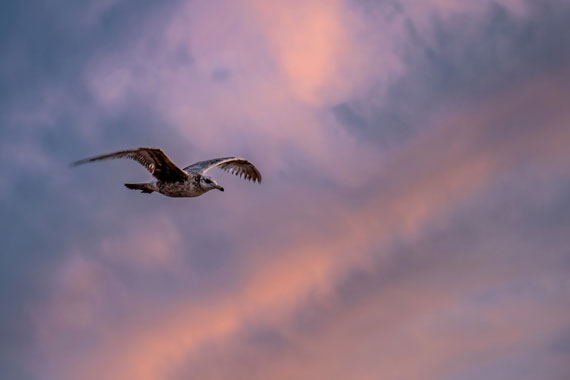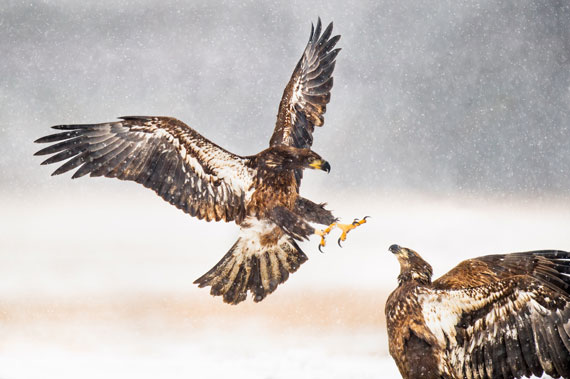Bird photography, especially capturing them in flight, combines both art and technique. This harmonious blend presents the allure and challenges of this niche. Successfully photographing a bird soaring through the skies is an exhilarating feeling. However, it does demand patience, practice, and the optimal use of equipment. Let’s delve deeper into this fascinating realm of photography.

Photo captured by Tim Mossholder; 70mm, f/3.5, 1/200s, ISO 125
Firstly, birds are unpredictable. Their rapid, often erratic movements mean that photographers must constantly adjust focus and composition in split-second decisions. This is further complicated by the speed at which many birds fly, demanding swift reflexes and a deep understanding of the camera’s capabilities. The high speed also necessitates the use of faster shutter speeds, which can introduce complications related to lighting and exposure.
Additionally, maintaining a sharp focus on a moving bird, especially against cluttered or similarly colored backgrounds, pushes the limits of a camera’s autofocus system. Balancing all these elements while also striving for a compelling composition—capturing the grace, power, or sheer beauty of a bird mid-flight—makes this one of the most challenging yet rewarding endeavors in the world of photography.
1. Choosing the Right Equipment
- Camera: For birds in motion, your camera’s performance is pivotal. Both DSLRs and mirrorless cameras with fast autofocus systems and high continuous shooting speeds will serve you well. These features will ensure you don’t miss out on that split-second action.
- Lens: The lens can make or break your shot. A telephoto lens, particularly ones that are 300mm or longer, can be very helpful. Such a lens allows you to get closer shots of the bird without physically moving closer, which might disturb the bird’s natural behavior.
- Tripod or Monopod: Especially with heavier lenses, it’s essential to have stability. A robust tripod or monopod can help eliminate camera shake, ensuring crisp, clear shots. A gimbal head on your tripod can be especially helpful, allowing for smooth tracking of birds in flight.
2. Optimal Camera Settings for Birds in Flight
- Autofocus: AF-C or continuous autofocus mode allows your camera to constantly adjust its focus as the bird moves, increasing the likelihood of a sharp shot.
- Focus points: Depending on the scenario and your preference, you can use a group of focus points or a single flexible focus point. This will help keep the bird sharp even if it moves unpredictably.
- Burst mode: Birds are fast and unpredictable. A high-speed continuous shooting mode lets you capture several frames in quick succession, giving you a variety of shots to choose from.
- Shutter Speed: A fast shutter speed (1/1000s or even faster) ensures the bird’s rapid motion is frozen in the frame, capturing every detail of its wings and feathers.
- Aperture: A wide aperture (low f-stop number) like f/2.8 or f/4 will create a shallow depth of field. This blurs the background, making the bird stand out and minimizing any distracting elements.
- ISO: This is a balancing act. You need to adjust the ISO for the right exposure, but going too high can introduce noise. Modern cameras handle higher ISOs pretty well, but it’s still crucial to strike the right balance, especially in low light conditions.

Photo captured by Ray Hennessy; 500mm, f/4.0, 1/2000s, ISO 1000
3. Mastering the Technique
- Pre-focus: If you know where the bird is likely to take flight or pass through, pre-focus on that spot. This means when the action happens, your camera will lock focus faster.
- Tracking: This requires practice. By keeping both eyes open, you can use your peripheral vision to follow the bird while also viewing it through your lens. The key is to pan your camera smoothly in tandem with the bird’s flight path.
- Timing: Sometimes, it’s about waiting for that perfect moment. Whether it’s the bird diving for prey or gliding effortlessly with its wings fully extended, patience often leads to the best results.
Observation and Research: It’s essential to spend time observing and understanding the birds you wish to photograph. Recognizing their behaviors and patterns can give you a hint when they might take off, turn, or perform other interesting maneuvers. Engage with local birdwatching groups or forums online. Their shared experiences can guide you to lesser-known spots or tell you the best times of day for certain activities.
Conclusion
While the above tips provide a foundation, remember that practice is the cornerstone of perfection. Every bird species has its own unique flight pattern and behavior. The more you observe and photograph, the better you’ll become at reading their movements, leading to those breathtaking shots that make every moment spent worth it. So, arm yourself with your camera, venture out, and let the skies become your canvas!
For Further Training:
Have you ever wanted to photograph an amazing once-in-a-lifetime moment but missed the shot? This new set of Photography Adventure Cheat Sheets have you covered. With camera settings and critical information on the most challenging photography situations, you’ll never be unprepared again. They are currently 80% off for the launch sale which ends soon if you want to check them out.
The perfect companion for any photographer. Print one out whenever you need it. Whether you’re going on vacation or seeking out a specific photography adventure, these cheat sheets can provide you with the knowledge and inspiration you need to create your best work yet.
Launch sale ending soon: The Photography Adventure Cheat Sheets at 80% Off
- - - - - - - - - - - - - - - - - - - - - - - - - - - - - - - - - - - - - - - - - - - - - - - - - - - - - - - - - - - - - - - - - - - - - - - - - -
Did you appreciate this newsletter? Please help us keep it going by Joining Our Patreon Supporters
What are your thoughts on this article? Join the discussion on our Facebook Page
PictureCorrect subscribers can also learn more today with our #1 bestseller: The Photography Tutorial eBook
- - - - - - - - - - - - - - - - - - - - - - - - - - - - - - - - - - - - - - - - - - - - - - - - - - - - - - - - - - - - - - - - - - - - - - - - - -
The post Chasing Feathers: Tips for Photographing Soaring Birds appeared first on PictureCorrect.
from PictureCorrect https://ift.tt/PQAFyIM
via IFTTT







0 kommenttia:
Lähetä kommentti